How to choose avocado for baby food
Avocado for babies: When can babies eat avocado?
Updated Oct 10, 2022
Avocado is an increasingly popular choice for baby’s first food — and with good reason. Its relatively mild taste and soft texture make it a comforting and easy choice for adults and babies alike.
If you’re thinking about introducing avocado to your baby, keep reading to find out why it’s a nutrient powerhouse and the best ways to serve it.
IN THIS ARTICLE:
Can babies have avocado?
Is avocado healthy for babies?
When can babies eat avocado?
How to introduce avocado for your baby
Is avocado a common allergen?
Is avocado a choking hazard?
Avocado for babies FAQ
Can babies have avocado?
Yes! Babies can have avocado starting around 6 months of age, when they start eating solid food. Make sure the avocado you’re feeding is soft and ripe before serving. At the store, choose a fruit that gives a little to gentle pressure and has dark, bumpy skin.
Is avocado healthy for babies?
Avocados are packed with nutrition for babies. They’re a good source of healthy fats and fiber as well as full of important vitamins and minerals. Plus, they’re tasty and easy to eat!
Avocado nutrients for babies
When it comes to nutrition, avocados are probably best known for their fat content. The healthy, unsaturated fats they contain provide your baby with much-needed energy and help support brain development. Avocados also contain:
Fiber
Potassium
Folate
B vitamins
Vitamin E
Introducing fruits (such as avocados) and vegetables early on can set your baby up to enjoy them over the course of their lifetime, potentially leading to better health outcomes. Additionally, research links avocado consumption to improved lifelong cardiovascular health, weight management, and type 2 diabetes outcomes.
Additionally, research links avocado consumption to improved lifelong cardiovascular health, weight management, and type 2 diabetes outcomes.
When can babies eat avocado?
Babies and toddlers of all ages can eat avocado. It's also a versatile food that doesn't need to be cooked, which makes it very convenient.
Can babies between 6 and 9 months old eat avocado?
Yes — babies 6 - 9 months old can eat avocados. Avocados are rich in healthy fat, which provides energy as well as helps your baby absorb other nutrients. Serve avocados in a puree or cut in strips for baby-led weaning.
Can babies between 9 and 12 months old eat avocado?
Definitely! Babies can continue eating avocados between 9 and 12 months old. As your baby develops their pincer grasp, you may serve them in cubes or include them with other foods.
Can babies over 12 months old eat avocado?
Babies over 12 months old can eat avocados, too! Toddlers may continue to enjoy avocados cut up or you can add them to other foods. Try mashed up on toast, blended into a smoothie, or scooped up as guacamole.
How to introduce avocado for your baby
Avocados are typically eaten fresh and can be enjoyed on their own or added to a variety of foods. Try:
A simple avocado toast
As a topping for tacos or quesadillas
In a salsa or a smoothie
Check for ripeness and rinse the outer skin before cutting.
Serving avocado for baby-led weaning
Many babies enjoy avocados when they start baby-led weaning around 6 months of age. Slice pinky-sized strips so they can be easily scooped up with your baby’s palm. If they are too slippery, roll slices in panko bread crumbs or leave a small amount of the skin on the bottom to create a handle. Once your baby uses their pointer finger and thumb to pick up food, you can serve in small cubes.
Slice pinky-sized strips so they can be easily scooped up with your baby’s palm. If they are too slippery, roll slices in panko bread crumbs or leave a small amount of the skin on the bottom to create a handle. Once your baby uses their pointer finger and thumb to pick up food, you can serve in small cubes.
Avocado puree for babies
Avocados are one of the easiest foods to serve as a puree. You can blend some up to make a smooth puree or you can simply mash up with a fork to create a more textured puree. Once your baby advances from purees (around 8 to 9 months), serve avocados cut into small cubes.
Is avocado a common allergen?
Avocado is not one of the common allergens, but it’s possible to have an allergic reaction to avocados. Oral allergies — characterized by itching around the mouth — and latex allergies sometimes occur when consuming or touching avocados. If you have any allergy concerns, call your pediatrician right away.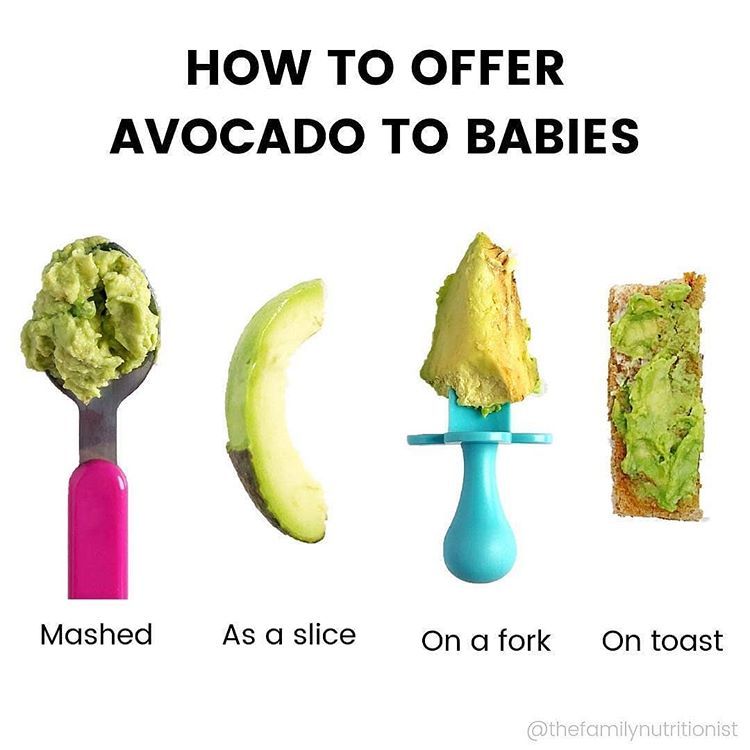
Is avocado a choking hazard?
Avocados aren’t considered to be a high-risk choking food, especially when they’re soft and ripe. Make sure to serve in a safe size and shape for your baby’s age and feeding ability to further reduce the risk of choking. Lastly, do a quick check for any pieces of the seed before serving it to your baby.
Avocado for babies FAQ
Q: Can I give avocado as a first food?
A:
Avocados are a great option for a first food! They are soft and easy to chew; plus, they have a likable, mild flavor. Serve in a puree or cut in strips for baby-led weaning.
Q: Can babies eat avocado every day?
A:
Babies can eat avocado every day, especially since it’s a highly nutrient-dense food. If your baby loves avocados, go ahead and serve them often. However, aim to include a variety of foods in your baby’s diet as well.
If your baby loves avocados, go ahead and serve them often. However, aim to include a variety of foods in your baby’s diet as well.
Q: Which part of an avocado should be given to the baby?
A:
Babies, just like adults, should eat the green flesh of the avocado. Peel the skin and remove all parts of the pit before serving.
Q: Is avocado good for teething babies?
A:
Yes — avocados can be a good choice for teething babies because they are so soft. Many babies eat less during the teething process, but this is only temporary. Serving easy-to-chew or cold foods sometimes helps!
How to Serve Avocado to Baby
Home » Feeding Style » Baby Food Purees » Stage One » How to Serve Avocado to Baby
Learn how to prepare avocado for baby in 4 delicious and easy ways! As yummy superfoods, avocados are ideal as the first food for babies – 6 months and up. Serve them as a baby food puree, mashed, or as finger food for baby-led weaning.
Serve them as a baby food puree, mashed, or as finger food for baby-led weaning.
Medically reviewed by Jamie Johnson, Registered Dietitian Nutritionist (RDN), and Lauren Braaten, Pediatric Occupational Therapist (OT).
Avocado Baby Food
Avocados 🥑 are one of my all-time favorite foods for babies!
Whether you are making all of your baby food or have tapped out in life and only want to make one homemade recipe for your baby, avocados would be my first and only recommendation.
Besides being affordable and easy to find, avocados are among the top healthiest foods for babies, if not the number one. You can easily have them blended into a smooth puree, smashed into a chunky puree, sliced into finger food, and cut into pieces with an easy-to-grip handle for baby-led weaning.
So, no matter what style of feeding you are doing with your little one, avocados have got you covered. 👍
Plus, after you are done making your baby an easy avocado meal, you can also slice some for your own snack! And in my opinion, every time avocado is involved in a meal; the day just gets better.
First time making homemade baby food? Then, I would suggest that you start by reading my very in-depth Guide on how to Make Homemade Baby Food – which goes over all the important information such as the best cooking tools to have on hand, safe storage, how to know when baby is ready for solids, how to introduce purees, the best first foods for baby, and more! If you are doing Baby-Led Weaning, then be sure to check out my Complete Guide to Baby-Led Weaning – which covers what exactly is baby-led weaning, to every parent’s concern of baby-led weaning and choking, this guide goes over it all. I will also share how to know when baby is ready for BLW, the top 10 best first foods, a helpful sample blw feeding schedule, helpful tools to have on hand, and much much more!
Want more information? Then make sure to check out my best-selling cookbook for even more information and recipes!
Avocado for Baby Video
Watch this video to see how easy it is to serve avocado to your baby!
Top Reasons to Serve Avocado to Baby- Avocados are beyond healthy for babies – they contain healthy fats that help your baby’s brain grow!
- They are fast – you can make and serve avocado to your baby in 30 seconds flat!
- They work for all feeding styles — puree, chunky puree, finger food, or baby-led weaning.
 How versatile!
How versatile!
Avocados are one of the most nutrient-dense foods on the planet, and I’m not exaggerating!
- Super Nutritious – Avocados are full of 20 different vitamins and minerals, most notably vitamin K, folate, vitamin C, potassium, vitamin E, magnesium, and vitamins B-5 and B-6, along with a good amount of fiber and heart-healthy fats.
- Health Benefits – They improve heart health, support eye, skin, and hair health, fight cancer cell growth, enhance digestive health, boost one’s mood, keep the nervous system healthy, provide healthy fats for brain growth, and are good for gross motor skills.
- Boosts Immunity – Avocados are loaded with antioxidants, anti-inflammation, and antimicrobial properties, which help prevent your baby from getting sick.
Ingredients
- Avocado: you will need half of ripe avocado for these recipes.
 Because avocados don’t keep well, I recommend making these recipes on-demand so the puree or solid food is fresh and free of any browning.
Because avocados don’t keep well, I recommend making these recipes on-demand so the puree or solid food is fresh and free of any browning. - Spices or Herbs: you can certainly add in a pinch of spice or herbs to your avocado puree. A pinch of freshly chopped cilantro, chives, parlsey, or mint would be tasty or you could add in a pinch of garlic powder, cumin, paprika, mild chili powder or a squeeze of lemor or lime juice.
Avocado Picking Tip: when shopping for an avocado, you want one that is darker in color and yields to firm gentle pressure. A ripe avocado will feel soft to the touch but not “mushy” when you press on it. You can store unripened avocados in the fridge until you are ready for them. You will want to take them out of the fridge and place them on the counter 1-2 days before you need them.
Tools Needed
- highchair
- suction bowl or baby bowl
- baby spoon
- open lid cup
- bib with catch pocket
- sleeved bib
- splat mat to cover the floor
- knives
- blender or food processor
Frequently Asked Questions
When can you introduce avocados to baby?
Whether you’re starting your baby on purees or are doing baby-led weaning, avocados are a wholesome and enjoyable first food for your baby! When a baby can start on solids is determined by their own rate of development, which generally comes between 4-6 months of age for purees and or after 6 months for baby-led weaning. Some of the developmental milestones your baby needs to reach in order to start on solids include: if your baby has solid control of their head and neck, if your baby has doubled in weight, and if your baby is reaching for or opening their mouth when you eat (see my guide here). Before you start baby on purees, you should consult with your pediatrician to make sure your child is developmentally ready.
Some of the developmental milestones your baby needs to reach in order to start on solids include: if your baby has solid control of their head and neck, if your baby has doubled in weight, and if your baby is reaching for or opening their mouth when you eat (see my guide here). Before you start baby on purees, you should consult with your pediatrician to make sure your child is developmentally ready.
Are avocados a choking hazard for babies?
Avocados are usually soft and easy for babies to chew. However, if an avocado is not ripe and ready to eat, the flesh will be harder and more of a risk to your baby. That said, it is best to serve mashed or small strips of avocado. When selecting an avocado for your baby, look for one that is ripe, soft (but not mushy), and has skin that’s easy to press your finger into. A ripe avocado will typically be darker green in color and have bumpy skin.
Is avocado a common allergen for baby?
No, avocado is not a common allergen, however, as with any food, start with a small portion and be aware of any signs that might be an allergic reaction after introducing it.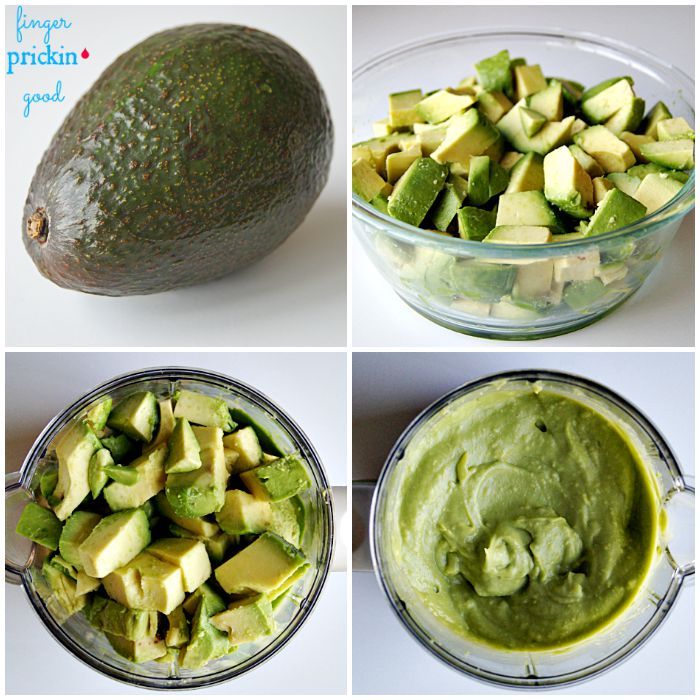
Does avocado cause constipation for babies?
No, avocado is not known to cause constipation in babies, and it can actually help relieve constipation in babies due to the high fiber content that makes it easier on your baby to pass stools.
Feeding Tips
- Follow your baby’s lead – when feeding purees from a spoon, sometimes there’s a tendency to keep offering bites past the point of your baby being full. Always follow baby’s cues for when they are done eating. Turning away from the spoon, closing her mouth, or pushing food away are all signs that baby is finished with the meal.
- Try adding a little seasoning or spice to purees – babies like flavor! Or consider changing the temperature of purees from time to time, to slightly warmed or slightly chilled. Varying these aspects adds to the sensory experience!
- Place a small amount of puree on the tray during spoon feeding – so that your baby can dip their fingers or hands in the puree.
 Allowing baby to explore foods in this way helps them learn to self-feed and can help them be more willing to try new textures and foods in the future.
Allowing baby to explore foods in this way helps them learn to self-feed and can help them be more willing to try new textures and foods in the future.
There are a variety of ways to prepare avocados for your baby. Here are 4 of my favorite ways:
- Mashed – This is a quick and easy way to make a chunky or smooth puree, ideal for babies 4-6+ months old.
- Sliced with Some Peel Left – When you leave the peel on half of a slice of avocado, you are making a little easy-to-hold handle for your baby. They can hold (or palmar grasp) the peel and then eat the peeled portion. It’s perfect for baby-led weaning (6+ months) or finger foods (9+ months).
- Smooth Puree – When blended with half of a banana, avocado becomes mouthwateringly smooth. This is great for babies 4-6+ months old who love smooth and creamy purees. Plus, it only takes 40 seconds to make.
- Slices Rolled in a Coating – This is another excellent alternative for babies who want to eat with their fingers but need a little help getting a good grip on the avocado slices since avocados can be a little slippery.
 You can do this option with slices or diced avocados. They’re also ideal for baby-led weaning (6+ months) or finger foods (9+ months).
You can do this option with slices or diced avocados. They’re also ideal for baby-led weaning (6+ months) or finger foods (9+ months).
Looking for more easy baby-led weaning and puree recipes? Then check out my favorite ways to serve apples and bananas to babies!
Mashed Avocado – Smooth or ChunkySmashed avocado is a hassle-free yet superb way to make a quick chunky or smooth puree. You can serve this to babies 4-6 months and up!
For baby-led weaning, I love to add this rich and thick puree to a slice of toast, pancake, or waffle for babies to self-feed. You can also serve it to them on a self-feeding spoon.
Instructions: Simply peel a quarter or half of a ripe avocado, place it on a cutting board, and mash it with the back of a fork. Mash until just chunky or until smooth. I have found that adding a small teaspoon of breast milk or formula helps make it incredibly creamy.
Avocado for Baby-Led WeaningThere are several ways you can serve avocado to your baby if you are doing baby-led weaning depending on your baby’s age.
6-8 months: cut avocado into thick slices and leave half of the peel on (see photo above) so your baby has an easy-to-grip handle.
8-10 months: slice the avocado into thin slices without the peel.
10-12 months: cut the avocado into small chunks so your baby can practice their pincer grasp.
Avocado Puree with BananaWhen you blend avocado and half of a banana, it becomes super-duper smooth. This is ideal for babies who love a rich, smooth, and creamy puree. Plus, it only takes 40 seconds to make!
Instructions: Place half an avocado and half a banana into a small blender or food processor and puree until smooth, adding a tablespoon of breast milk, formula, or water if needed.
Coated Avocado SlicesThese coated avocado slices are another healthy option for babies that want to eat with their fingers but need a little help getting a good grip on the avocado slices since avocados can be a little slippery. You can opt for slices or diced avocados as well once your baby has developed their pincer grasp.
You can opt for slices or diced avocados as well once your baby has developed their pincer grasp.
Instructions: Slice and peel avocado and roll in hemp seeds, whole wheat bread crumbs or crushed baby puffs.
Or watch a shortened version of this video here.
MASHED AVOCADO – SMOOTH OR CHUNKY- 1/4 avocado
- 1 tsp breast milk, formula or water (optional)
- 1/4 avocado
- 1/2 avocado
- 1/2 banana
- 1/4 avocado, sliced and peeled
- 2 tbsp hemp seeds, breadcrumbs or crushed baby puffs
Place the avocado on a cutting board, and taking the back of a fork, smash until you get your desired consistency.
 For a smooth puree, add in the liquid and smash until smooth.
For a smooth puree, add in the liquid and smash until smooth.
Cut a slice of avocado with the peel on. Using a sharp knife, cut the peel 1/3-1/2 the way up the side of the avocado until you get to the flesh. Do not cut all the way through the avocado slice. Take the peel off and serve the avocado slice to baby with them holding the peel that is still on the avocado.
Place the avocado and banana in a small blender or food processor. Puree for 1 minute or until smooth, adding in liquid if needed.
Take the sliced and peeled avocado and roll in the hemp seeds, breadcrumbs or crushed baby puffs.
Age: 4-6 months for purees, 6+ months for baby-led weaning
Yield: 1 serving
Storage: If saving any leftover avocado or avocado puree, since it’s likely baby will not eat the entire avocado, squeeze a few drops of lemon or lime juice on the avocado to prevent it from turning brown.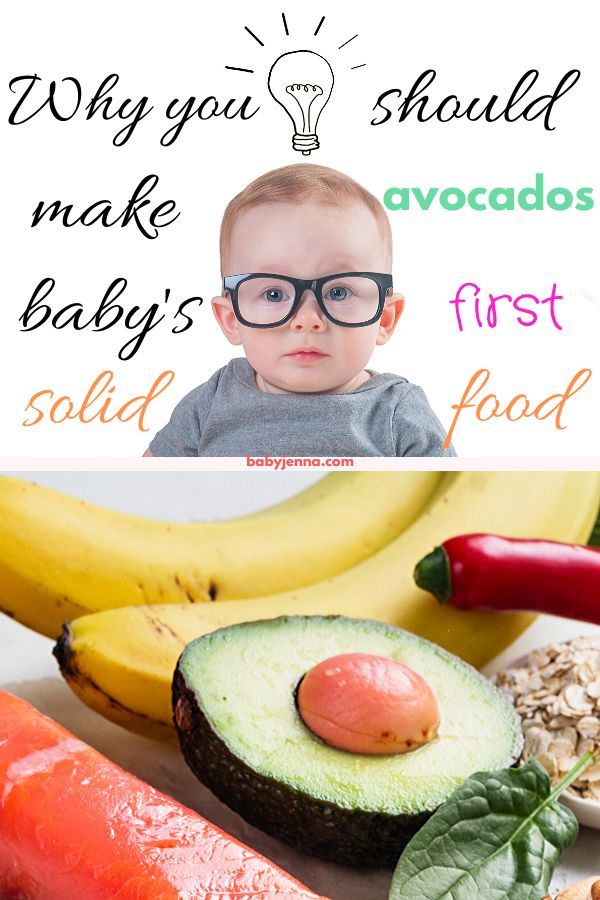 Avocado puree or strips will last 1-2 days in the fridge. Avocado puree can be frozen with a little lemon or lime juice mixed in for up to 2 months.
Avocado puree or strips will last 1-2 days in the fridge. Avocado puree can be frozen with a little lemon or lime juice mixed in for up to 2 months.
Grabease Utensil
Tripp Trapp High Chair
Bumkins Baby Bowl
Did you make this recipe?
Tag @babyfoode on Instagram and hashtag it #babyfoode!
Pin <em>Recipe</em> Email <em>a Friend</em>
at what age can you give?
Child's birthday » Baby food » At what age can avocado be given to a child?
06/21/2016
Contents
- 1 What causes controversy in the scientific community
- 2 Avocados for the first complementary foods
- 3 How should an avocado look like?
- 4 How to choose a healthy avocado?
- 5 Storage conditions
- 6 Contraindications
- 7 Video: Feeding a baby from 4 months
The positive properties of avocados lie in the large number of useful substances contained in it. This is a whole complex of vitamins and minerals. Useful for digestion is the fruit fiber of a ripe avocado grated into gruel. It should be noted that its calorie content is very high - 20Kk per 100 grams of product.
Useful for digestion is the fruit fiber of a ripe avocado grated into gruel. It should be noted that its calorie content is very high - 20Kk per 100 grams of product.
What causes controversy in the scientific community
Avocado is one of the healthiest foodsThis fruit is often prescribed for adults to lower cholesterol. For a week of systematic intake, indicators in adults decrease by 30%. The crumbs cannot have such problems with cholesterol, as well as cataracts. In addition to preventing all age-related changes, avocados prevent the development of cancer cells. nine0003 Nutritional value and chemical composition of avocado
For children, this fruit is useful because the microelements contained in it contribute to the development of physical and mental. Scientists argue about the age at which avocados can be given to children. And this is in America, where this fruit has long been an integral part of the diet.
For Russia, avocado is an exotic product, which once again speaks against it. It has always been believed that vegetables and fruits that grow in the region where a person lives bring the greatest benefit. nine0003
It has always been believed that vegetables and fruits that grow in the region where a person lives bring the greatest benefit. nine0003
Given that the avocado is also a strong aphrodisiac, the need for its introduction into the children's diet remains in question.
Avocado for the first food
The delicate texture of the first fruit food is easier for the baby's body to digest than the puree of vegetables and herbs. A more subtle unobtrusive taste also speaks in favor of fruit rather than vegetable complementary foods. But is it so important to give all the vitamins and minerals at once when you can please your child with a variety of flavors of fruits and vegetables that are less high in calories and do not contain "adult" vitamins. For example, "Omega-3" may be an extra addition to the mandatory vitamin "D" complex for babies. nine0003 Despite the variety of avocado recipes for children, it is better to consult a doctor.
When introducing avocados into baby food, consult your doctor. Advice on the age at which to give avocados is mixed.
It is better to introduce avocado after applesauceSome scientists are of the opinion that this fruit should not be given to children under 1 year old. Others recommend it as the first complementary food. Here again, the exact age cannot be named, because the first complementary foods for breastfed children are recommended to be introduced no earlier than the baby is 6 months old. nine0003
The stomach of a bottle-fed baby is ready to accept tender fruit pulp from 3-4 months. As a rule, for 3-month-old children, applesauce becomes the first complementary food. Avocado has a delicate texture similar to an apple. Its taste is not bright, which can be a good addition to milk. But still, you can enter it a month after the first apple food and banana samples.
What should an avocado look like?
With the appearance of avocados, not everything is clear due to the large number of its varieties. On Russian shelves, you can most often find 4 varieties out of 400 - these are:
On Russian shelves, you can most often find 4 varieties out of 400 - these are:
- "Gwen" - the fruits of this variety are oblong and rather large. Their skin is deep green. The flesh is yellow-green. The closer to the bone, the more yellow.
- "Reed" also refers to large-fruited varieties. The shape of the fruit is round, the flesh is light yellow, covered with a thick pimply skin of dark green color.
- Sweetish pulp under a smooth green skin is hidden in large fruits of the Fuerte variety.
- The most common pear-shaped fruits of medium size are the fruits of the Zutano variety. The flesh of the fruit is often white, sometimes yellowish. The smooth skin is easy to peel off. nine0010
There are a lot of varieties, so it is difficult to distinguish which of the fruits is ripe and which is not by the appearance of the peel. The main thing is that the peel is green, not purple. For some varieties, the brown color of the fruit peel is acceptable.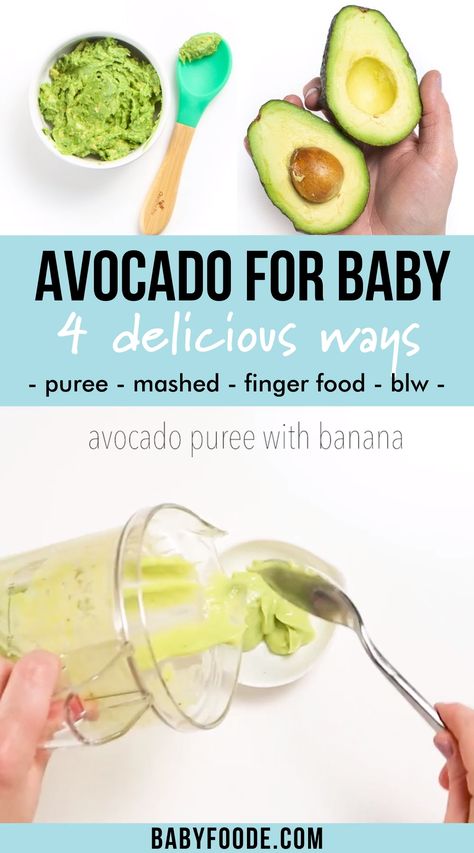
How to choose a healthy avocado?
"Maturity" avocadoWhen choosing an exotic fruit, you can trust your hands and ears. The first step is to touch the fruit: if it is too hard and when pressed with your fingers, its shape remains unchanged, it is not ripe. The soft fruit of the avocado belongs to the category of overripe. There is a high possibility that under a dense peel the process of decay or fermentation has already begun. It is necessary to choose the golden mean. An obligatory criterion when checking the fruit is the restoration of its original shape after pressing. There should be no dents on the peel. nine0003
It's even easier to tell when an avocado is ripe by ear. When shaking it, the stone should make a sound of hitting the shell. If this does not happen, the fruit is not ripe, the grain in the stone fits snugly.
When choosing between unripe and overripe avocados, it is better to give preference to the first. After a couple of days of lying, he will reach the required condition, like a pear.

Storage conditions
Avocados are best stored at room temperatureStore at room temperature. You can’t put it in a freezer or refrigerator - this fruit does not tolerate sub-zero temperatures, it deteriorates very quickly if stored improperly. Like all fruits, it must be eaten fresh, only then it will give the maximum benefit to the body and will not cause harm. nine0003
Contraindications
Possible cross-reactions are detected in the diagnosis of allergiesThe worst thing to give avocados to children suffering from latex allergies. At first glance, latex and fruit are unrelated. Upon a detailed study of the problem, it turned out that intolerance to bananas, apples, cherries, papaya, melons, tomatoes can subsequently affect cross-allergy. This will lead to severe forms of dermatitis on skin contact with latex products.
The threat of avocados is that latex proteins from the sap of euphorbia and mulberry trees are similar to those found in avocados.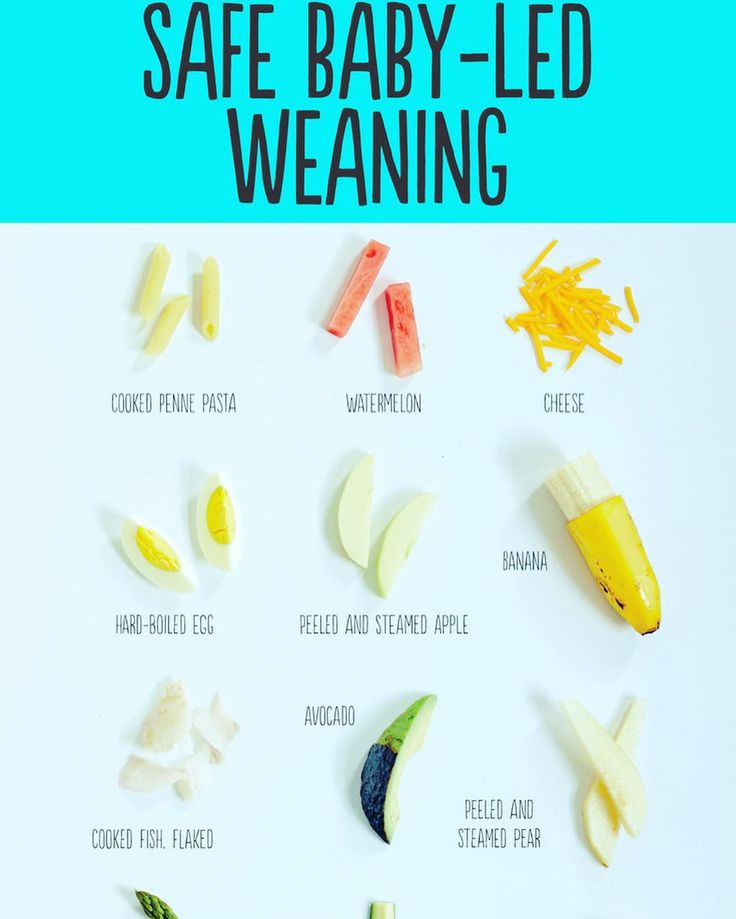 Latex products, which include nipples and pacifiers, with such a disease, will provoke the production of IgE. This type of immunoglobulin leads to the clinical manifestations of an allergic reaction. nine0003
Latex products, which include nipples and pacifiers, with such a disease, will provoke the production of IgE. This type of immunoglobulin leads to the clinical manifestations of an allergic reaction. nine0003
In order not to condemn the child to suffering, it is necessary to consult a doctor before introducing exotic complementary foods. If the baby has problems after trying bananas, then avocados should not be given to him.
Video: Complementary foods from 4 months
Didn't find your organization?
Add now!
2016-06-21
Previous Children's Day idea
Next Using ginger in children's diet
See also
About the benefits of chamomile tea for children
Contents1 What is it?2 Useful properties3 Instructions for use3.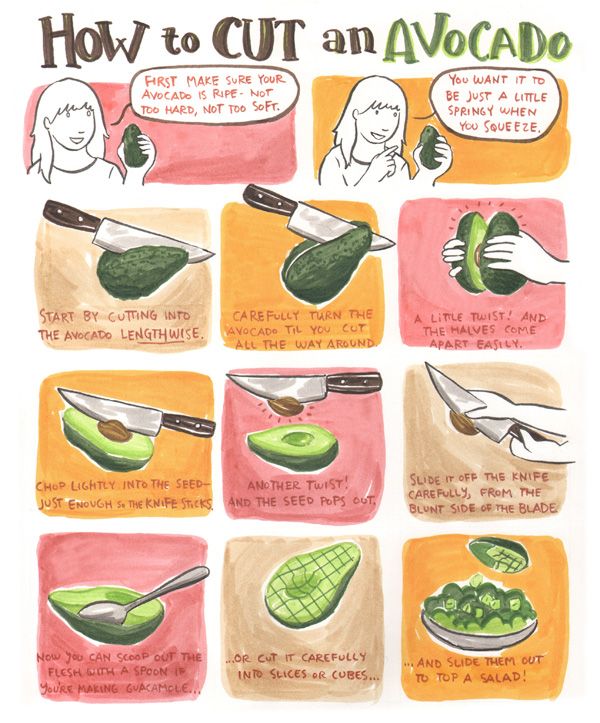 1 How to brew?4 Age restrictions and ...
1 How to brew?4 Age restrictions and ...
from what age and how much?
› ›
In our country, avocado (the second name is American Perseus) is not particularly popular, but some mothers are still interested in whether it is possible to give it to a child. Let's try to answer this question, based on the experience of children's nutritionists abroad. nine0003
Photo: Depositphotos.com. Author: StephanieFrey.
Until the age of 6 months, the baby's body is not able to cope with any solid food on its own. The only thing that is allowed to feed such a crumb is breast milk and adapted milk formulas.
But even if your child has grown to complementary foods, do not rush to introduce avocados into his diet. You need to start with more traditional vegetables and fruits.
Content
- Age limits
- Nutritional value
- Starting with puree
- How to choose?
- When not to give
Age limits
You can start introducing your baby to avocado after one year. Although some especially advanced parents give this fruit puree to their children as a first meal. In foreign forums, disputes about this do not subside. But it's better to play it safe.
Although some especially advanced parents give this fruit puree to their children as a first meal. In foreign forums, disputes about this do not subside. But it's better to play it safe.
Nutritional value
The fruit is highly nutritious, rich in vitamins A, C and B, minerals and healthy omega-3 unsaturated fats, chemically close to whole milk. Such fats are useful for the development of children's brains. nine0003
Free from sodium and cholesterol.
Contains: folic acid, dietary fiber, potassium, iron and vitamin E, carotenoids: lutein and beta-carotene. There is more potassium in green fruits than in 45 other vegetables and fruits used for complementary foods.
Another indisputable plus: light, unobtrusive taste and delicate texture. This combination will appeal to many kids.
Starting with puree
Fruit pulp can be used to make a light, creamy puree that is easy for a child to chew and swallow. nine0003
If the fruit is ripe enough, simply peel it and mash it with a spoon. Boiling and steaming is not necessary. Using a food processor or blender will result in a thinner consistency.
Boiling and steaming is not necessary. Using a food processor or blender will result in a thinner consistency.
Avocado is combined with other fruits and vegetables, so it can be used in the preparation of multi-ingredient purees. Traditional companions: apple, peach, pear, banana and yogurt. But carrots, beets and spinach contain nitrates, so before introducing them into the children's diet, you need to talk with a pediatrician. nine0003
Follow the general rules for introducing complementary foods. After the first acquaintance of the baby with a new product for him, you must wait 3 days to make sure that there is no allergy.
To reduce stress on the baby's digestive system, the first puree of avocados is recommended to be mixed with breast milk or infant formula.
How to choose?
- When choosing avocados for baby food, pay attention to their density. Too hard fruits are unripe. Too soft speak of overripeness, which means that rotting has already begun in their pulp.












